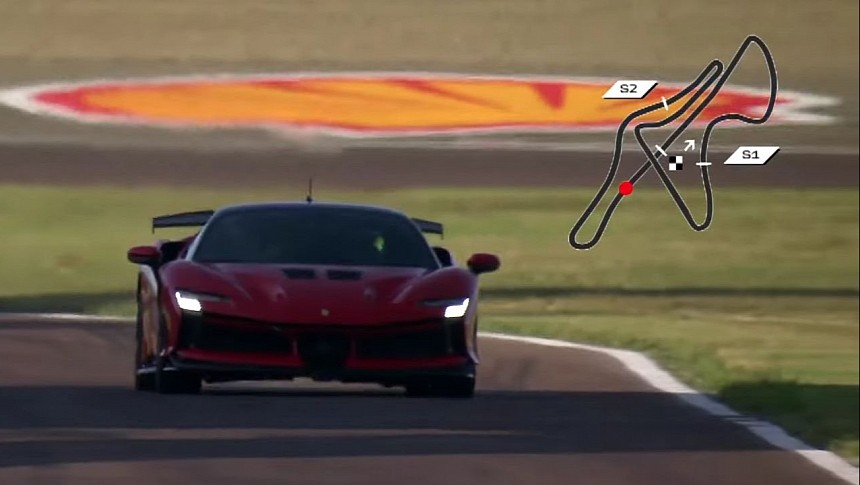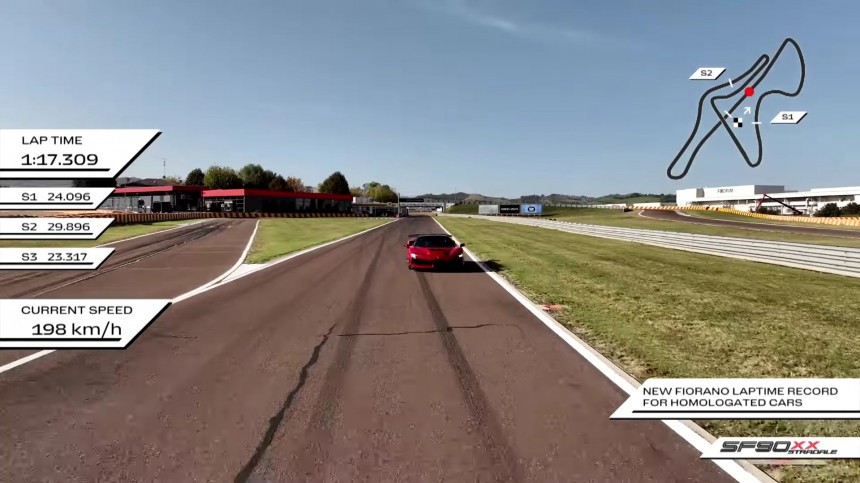Inaugurated on April 8 of 1972, what Ferrari calls Pista di Fiorano is a private racetrack constructed for development and testing the Prancing Horse's racing cars and series-production cars. The quickest lap time is credited to Michael Schumacher in the F2004 back in 2004, namely 55.999 seconds. When it comes to production vehicles, the SF90 Stradale lapped the circuit in 1:19.00 a mere four years ago.
Fast forward to 2023, and the SF90 XX Stradale moved the yardstick to 1:17.309 with Ferrari development engineer and test driver Raffaele de Simone behind the wheel. In the first three years at Ferrari, the guy also studied at Universita di Bologna to get a master's degree in mechanical engineering.
Precisely 2.997 kilometers long, which is 1.862 miles for those in the United Kingdom and the United States, the Fiorano circuit features a figure-eight layout. Suzuka, anyone? The 599 GTB Fiorano is named after said track, and Fiorano's name further carries over to the Assetto Fiorano track package.
Assetto Fiorano is the Italian automaker's way of saying a bit lighter and better in the corners. The SF90 XX, however, isn't available with this option because it comes with all the bells and whistles from the outset. Limited to 799 units for the berlinetta (a.k.a. Stradale) and 599 units for the roadster (make that Spider in Ferrari vernacular), the SF90 XX is the first-ever XX model you can drive on public roads.
The XX program kicked off in 2005 with the Ferrari Enzo-based FXX, followed by the 599XX in 2010 and FXX-K in 2014. It's not the most exotic program to come out of Maranello, though. Beginning in 2003, the F1 Clienti program has offered well-to-do peeps the chance to purchase and run Scuderia Ferrari Formula 1 racecars on world-class racing circuits without worrying about maintenance and logistics.
Turning our attention back to the SF90 XX, the most powerful series-production Fezza yet combines three electric motors with a twin-turbocharged V8, a dual-clutch transmission without reverse gear, and 7.9 kilowatt hours worth of energy stored in a high-voltage battery. Its capacity shouldn't come as a surprise. Rather than giving this plug-in hybrid the kind of range you'd expect from a PHEV, the Prancing Horse preferred to keep thighs light and tidy to maximize both on-track and on-road capability.
The search for lightness can also be noticed with the dual-clutch transmission, which doesn't feature a reverse gear because Ferrari programmed the front drive units for that. Be that as it may, the SF90 XX does weigh a lot. Ferrari claims 1,560 kilograms dry, meaning 3,439 pounds without the driver, cargo, and fluids. By comparison, the KERS-infused LaFerrari used to tip the scales at circa 1,250 kgs (2,756 lbs).
The LaFerrari and SF90 XX, however, are completely different animals under the skin. The same can be said about the upcoming F250, which serves as the replacement for the LaFerrari rather than the SF90 series. The SF90's heir apparent has recently been spotted testing with larger side air intakes, meaning a bit more power and torque for the twin-turbocharged V8 from the F154 engine family.
The F250 features a 120-degree sixer, although it remains to be seen if the V6 in question has the same displacement as the 3.0-liter unit in the 296 series. Internally referred to as F163, said engine powered the 499P racer to victory at the 24 Heures du Mans.
Precisely 2.997 kilometers long, which is 1.862 miles for those in the United Kingdom and the United States, the Fiorano circuit features a figure-eight layout. Suzuka, anyone? The 599 GTB Fiorano is named after said track, and Fiorano's name further carries over to the Assetto Fiorano track package.
Assetto Fiorano is the Italian automaker's way of saying a bit lighter and better in the corners. The SF90 XX, however, isn't available with this option because it comes with all the bells and whistles from the outset. Limited to 799 units for the berlinetta (a.k.a. Stradale) and 599 units for the roadster (make that Spider in Ferrari vernacular), the SF90 XX is the first-ever XX model you can drive on public roads.
The XX program kicked off in 2005 with the Ferrari Enzo-based FXX, followed by the 599XX in 2010 and FXX-K in 2014. It's not the most exotic program to come out of Maranello, though. Beginning in 2003, the F1 Clienti program has offered well-to-do peeps the chance to purchase and run Scuderia Ferrari Formula 1 racecars on world-class racing circuits without worrying about maintenance and logistics.
The search for lightness can also be noticed with the dual-clutch transmission, which doesn't feature a reverse gear because Ferrari programmed the front drive units for that. Be that as it may, the SF90 XX does weigh a lot. Ferrari claims 1,560 kilograms dry, meaning 3,439 pounds without the driver, cargo, and fluids. By comparison, the KERS-infused LaFerrari used to tip the scales at circa 1,250 kgs (2,756 lbs).
The LaFerrari and SF90 XX, however, are completely different animals under the skin. The same can be said about the upcoming F250, which serves as the replacement for the LaFerrari rather than the SF90 series. The SF90's heir apparent has recently been spotted testing with larger side air intakes, meaning a bit more power and torque for the twin-turbocharged V8 from the F154 engine family.
The F250 features a 120-degree sixer, although it remains to be seen if the V6 in question has the same displacement as the 3.0-liter unit in the 296 series. Internally referred to as F163, said engine powered the 499P racer to victory at the 24 Heures du Mans.



















